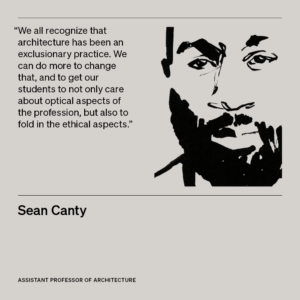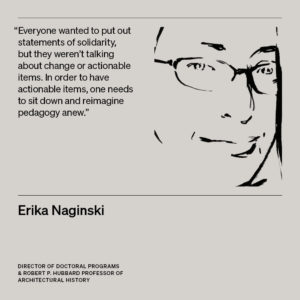Erika Naginski, Director of Doctoral Programs & Robert P. Hubbard Professor of Architectural History, and Sean Canty, Assistant Professor of Architecture
Several weeks ago, the African American Student Union and Africa GSD published the Notes on Credibility statement, which included 13 actionable demands to the GSD. What’s your response to the statement?
 Sean Canty (SC): A week before the Notes on Credibility document was published, Erika and I were having a candid conversation about recent events, which is why we wanted to respond together. We discussed the ways that our core education can rethink some of the issues surrounding spatial injustice, but for us, this question is fundamentally a question of time.
Sean Canty (SC): A week before the Notes on Credibility document was published, Erika and I were having a candid conversation about recent events, which is why we wanted to respond together. We discussed the ways that our core education can rethink some of the issues surrounding spatial injustice, but for us, this question is fundamentally a question of time.
 Erika Naginski (EN): As we watch these events unfold, educators and the design practices need some time to think, analyze, and explore. Sean and I wanted a chance to do that rather than respond immediately. One of the reasons we started talking was that everyone wanted to put out statements of solidarity, but they weren’t talking about change or actionable items. In order to have actionable items, one needs to sit down and reimagine pedagogy anew.
Erika Naginski (EN): As we watch these events unfold, educators and the design practices need some time to think, analyze, and explore. Sean and I wanted a chance to do that rather than respond immediately. One of the reasons we started talking was that everyone wanted to put out statements of solidarity, but they weren’t talking about change or actionable items. In order to have actionable items, one needs to sit down and reimagine pedagogy anew.
Do you believe it’s possible to retool existing design pedagogy, or should design institutions abandon the current curriculum and start fresh?
SC: Retooling from within might be a more responsible approach to address things now. We all recognize that architecture has been an exclusionary practice. We can do more to change that, and to get our students to not only care about optical aspects of the profession, but also to fold in the ethical aspects.
EN: I think that’s beautifully put and I really agree with it. In order to understand systemic racism and typology, we must examine the long history of architecture before it became a discipline. How do you talk about race, exclusion, and gender when there isn’t simply the heroic figure of the architect? You have to talk about race, slavery, and the Civil War. That’s a long history that has an impact and mode of intersection with architecture, urban planning, and urban design. This goes to the heart of how we move beyond the presentism of this conversation. It’s so much more than just recognizing practitioners of color or women.
SC: I am thinking about one of the ways that we can “retool” how we teach. At the GSD, our major disciplines are landscape, architecture, and urban planning—and urban design, which falls at the intersection of all three of those disciplines. How can we foster more of a connection across those four departments? It’s been happening more over the past few years, but we need to capitalize on that history without squandering the specificities of the disciplines.
EN: Each department has its own core. How do we stitch together the interstices and enable a serious intellectual understanding of the necessary points of collision and coalescence?
Is this an opportunity to introduce a kind of cross-departmental curriculum on the history of spatial injustice in the United States, as well as an anti-racism 101 design course?
SC: It’s a beautiful idea that’s worth exploring. And I think that going beyond a core curriculum, the studio program can be indispensable because it’s at the intersection of all those disciplines. I recently taught “Multiple Miamis” with Lily Song and Chris Reed (the second edition was with Eric Höweler and Corey Zehngebot), and it was such an enriching experience. The studio enabled specificity while creating a collaborative conversation between urban designers and architects and planners. For students to understand a site, and learn how they can operate social and political apparatuses around that site, to discover those linkages—particularly in the context of a real American city, for all of the international students—is hugely helpful.
EN: I’m wondering how can we fold back those ideas into the core. When we were talking about the architecture core, the first semester tends to be small-scale, formal. It’s not even at the level of the building—much less program or type. Then in Core 2, there begins to be an elaboration, or the hint of program. The minute we start inserting program or type, we can’t think of these as purely abstract or ideational modalities. We have to start thinking about history, context, power structure, race, gender, institutional structures, urban, and rural.
SC: Core 1 introduces students to the discourse and discipline, the intrinsic thing. Core 2 implements the external factors—ethics and social elements, for example. Core 3 is the integrative studio, where complex systems and robust institutional programs are introduced. Core 4 addresses issues of collective housing, medium skill, and medium density.
EN: All disciplines have their different intellectual traditions. One thing that strikes me is that maybe we are at a junction where form and function are too separate. Has a formalist discourse attached itself to design? Is it in the context or the content?
What’s the relationship of formalism to context? Maybe in our core, we’re so used to a kind of abstraction and ideational approach. We need to suture together form and content.
SC: It’s true. You can’t really have content without form, or form without content. We’ve been foregrounding that in our pedagogy.
How was the “Multiple Miamis” studio useful for thinking about the link between pedagogy and practice, and the kinds of conversations surrounding design justice across disciplines at the GSD?
SC: These are all stakeholders—activists and developers—for the same place. Fostering those kinds of connections was quite meaningful. It wasn’t easy all the time; there were a lot of difficult conversations between students, developers, and activists about more responsible spatial practices in our cities. One stakeholder alone can’t do that. It requires everyone to come together to hash these things out.
We find ourselves in disciplinary silos at the GSD. We need to find ways to have these meaningful connections and teach our students how to use them.
EN: With architecture specifically, it’s a question of how to get people in the door at all. Alongside systemic racism, there’s an economic reality: it’s the lowest paid of all the design professions. If you’re coming from a disadvantaged place, medicine or law is a safer bet than architecture. To make design accessible, there has to be a better access point to get young Black students and faculty through the door.
We need to get people of color to want this profession. It’s really important, and it’s not just going to happen through people saying “We have a scholarship.” It’s a broader educational commitment and we have to start much earlier.
Beyond changes to pedagogy, how can the GSD leverage its influence and financial resources to make design education a more equitable and accessible field?
SC: The GSD needs to amplify existing voices within the discipline and add more voices, so that the representation is there. If you scroll through any institution’s website, you can certainly see that there’s not a lot of people who look like me. For prospective students, it’s important to have people there who look like them, so they see it’s something that they can do.
The GSD also needs to give renewed attention and resources to platforms like Project Link and Design Discovery. They should be centralized in the GSD’s operations, and be way more robust in terms of outreach. Project Link is a high school program in the GSD with relationships with Boston high schools and elementary schools. Design Discovery is for people in college or older.
Undergraduate programs can start doing this work as well. The GSD should redraw the ways in which one can enter. We have the facilities and resources to bring in more Black students and staff, but it’s a question of the GSD opening the doors.
Sean Canty is assistant professor of architecture at the Harvard Graduate School of Design and founder of Studio SC, a design practice that activates environments by conjoining discrete geometries, materials, and architectural types.
Erika Naginski is Professor of Architectural History. Her research interests include Baroque and Enlightenment architecture, early modern aesthetic philosophy, theories of public space, and the critical traditions of architectural history.